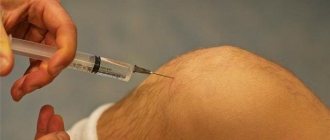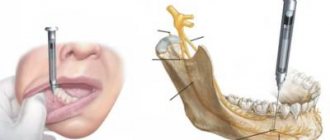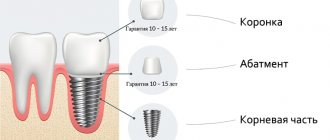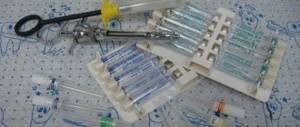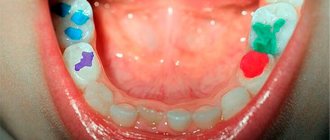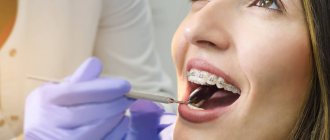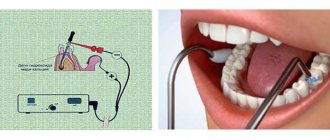Indications for removal of baby teeth
In children aged 6-7 years, the process of natural tooth replacement begins, the roots of baby teeth gradually dissolve, the crowns become loose and fall out on their own.
In some cases, the help of a dentist is still required:
- caries in an advanced stage, when tooth restoration is not possible;
- tooth decay caused by trauma;
- the crown of the tooth is already loosened, but does not fall out, causing discomfort to the child and injuring the gums;
- The permanent tooth has already begun to emerge, but the milk tooth is still firmly seated and does not make room;
- orthodontist recommendations for the formation of a correct bite;
- fistula, periodontitis, cyst.
Removal of incisors is most often associated with fractures and chips caused by trauma.
Advantages of the method
The growing popularity of drug sedation in modern medicine and dentistry can be explained by the presence of a number of undeniable advantages in this method. These include:
- effective elimination of psychological discomfort and any negative emotions;
- potentiation of the action of the local anesthetic, which allows for better elimination of the pain factor;
- the possibility of contact between the patient and the dentist (the patient can respond and comply with the doctor’s requirements);
- high safety and absence of toxic effects of sedation drugs on the body;
- easy recovery period;
- the ability to combine several types of dental treatment in one visit to the doctor;
- the possibility of an individual approach to each patient thanks to a wide range of drugs and routes of administration to provide drug sedation.
!Important: Therefore, if there is a choice whether to give the patient general anesthesia during tooth extraction or limit himself to drug sedation, in the vast majority of cases sedation is the best option.
When are permanent teeth removed?
Removal of permanent teeth in children is practiced only if there are serious indications:
- advanced or complicated carious process;
- complicated inflammatory processes accompanied by mobility of the crown;
- fracture of the crown of a tooth or its root;
- orthodontic treatment, when you need to make room for the development of other teeth;
- the appearance of supernumerary teeth that violate the integrity of the dentition;
- An unerupted tooth that cannot develop.
Wisdom teeth grow in after 18 years or more, but sometimes it is necessary to remove their buds in childhood. The reasons may be prerequisites for malocclusion, lack of space for the development of chewing teeth.
The decision to remove a permanent tooth is made after an x-ray and consultation with specialized specialists.
In what cases should sedation not be performed?
Despite its high safety, sedation, like any medical procedure, has a number of contraindications. This method of pain relief is not recommended for people suffering from drug addiction, withdrawal symptoms, certain pathologies of the nervous system or mental disorders.
Use sedation with caution in patients with a history of brain or spinal cord injuries. Any acute inflammatory processes in the body, as well as severe decompensated diseases of internal organs are contraindications to drug sedation. Before administering anesthesia, the doctor should also check to see if the patient is allergic to the sedation medication.
Types of anesthesia
If you need to remove a baby tooth that is already loose, this can often be done without anesthesia. In other cases, pain relief is required. Modern anesthesia drugs do not have a negative effect on the child’s body; their use is recommended by the Ministry of Health and STAR (Russian Dental Association).
In dentistry, several methods of pain relief are most often used:
- local anesthesia;
- general anesthesia (anesthesia);
- sedation
Local anesthesia
Methods of local anesthesia used in dentistry to treat children:
- application - the drug is applied to the surface of the tissue, it anesthetizes the mucous membrane for a short time, is used for anesthesia before an injection or before extracting a loose tooth;
- infiltration – the medicine is administered by injection into the mucous membrane of the gums to anesthetize the tissues surrounding the tooth;
- conductive – allows you to anesthetize and block the trunk of the nerve innervating the neurovascular bundle of a given tooth.;
- intraligamentary - a method of anesthesia in which the medicine is injected into the tissue between the root cement and the socket.
When teeth are removed, children often use two-stage local anesthesia: first, the gums are numbed with “tasty” gels or solutions, and then the medicine is administered by injection. For injections, toy attachments are used so that the child is not afraid of the syringe.
General anesthesia
Immersion in a state of anesthesia occurs through intravenous administration of drugs or through a mask. In this state, the child does not feel pain, his muscular system is completely relaxed. Indications for the use of general anesthesia are:
- the need for dental intervention in a child under 2 years of age;
- difficult removal;
- severe fear in the child;
- removal of several teeth;
- allergies to painkillers;
- large volume of treatment
- neurological diseases.
The decision to use anesthesia is made taking into account all the characteristics of the child’s body.
Sedation
The oxygen-nitrogen sedation technique allows the child to remain conscious and respond to the doctor’s questions. Through a special mask, the child inhales gas (nitrous oxide), with the help of which he relaxes and calms down.
Inhalation sedation does not require preliminary preparation (except for eliminating food 4 hours before).
For tooth extraction, sedation is used in combination with local anesthesia: gas inhaled through a mask calms the patient, and the anesthetic numbs the desired area. The effect occurs within a few minutes and ends when the gas supply is stopped.
Oxygen-nitrogen sedation in pediatric dentistry is a safe sedative. Nitrous oxide does not cause addiction or allergies, does not bind to blood proteins and is completely eliminated from the body through the lungs within a few minutes. Oxygen-nitrogen sedation has been used in world dentistry for more than fifty years.
Alternatives to anesthesia
If the main reason for considering the possibility of using anesthesia during tooth extraction is the child’s fear, then as an alternative, a simpler way to solve the problem can be offered. We are talking about the use of a method such as oxygen-nitrogen sedation, which has nothing to do with anesthesia. The child simply inhales a mixture of sedative gases through a mask and psychologically relaxes. Thus, after the teeth are removed, he is left with only positive emotions. At the same time, during sedation, the baby does not sleep, is conscious, breathes and speaks independently. In parallel with sedation, local anesthesia is used to eliminate pain. However, it is not recommended to use this method if the child does not have nasal breathing or during periods of exacerbation of chronic diseases.
How does tooth extraction occur under anesthesia?
To prepare for surgery, a preliminary visit to the pediatrician and a comprehensive examination are necessary.
Next, you need to follow these steps:
- Preparation at home. The child should not eat 6 hours before the doctor’s appointment, and drink water 2 hours before the doctor’s appointment.
- Anesthesia. Immersion in a state of medicated sleep by administering the drug occurs under the supervision of an anesthesiologist (a specialist is nearby until the patient is induced).
- Delete. Includes extracting the tooth itself and its roots, checking the complete removal of all roots, and treating the wound.
- Coming out of anesthesia.
After waking up, the child remains under the supervision of specialists for several more hours. Parents receive doctor's recommendations.
Is sedation safe?
Some patients may be reluctant to undergo medical sedation, even if they have an indication for this procedure.
However, drug sedation is considered an absolutely safe method and, unlike general anesthesia, is not accompanied by high health risks. For medical sedation, the doctor uses one or two effective but safe drugs that immerse the patient in a state of calm and relaxation. Unlike combinations of narcotic drugs for general anesthesia, which have a significant inhibitory and toxic effect, medications for sedation do not cause side effects and are well tolerated.
Also, when undergoing sedation, the patient will avoid such unpleasant consequences of general anesthesia as dry mouth, nausea, dizziness, chills and muscle pain. After drug sedation, the patient comes to his senses quite quickly and immediately feels good. Therefore, if your dentist offers you a tooth extraction under sedation, you should not be scared and refuse. This method will greatly facilitate the emotional perception of the upcoming intervention and will not have a negative impact on your health.
!Important: Ultra-short-acting sleeping pills are excreted in the urine within a few hours. After the first visit to the toilet, there are no drugs for sedation in the blood.
Treatment under general anesthesia (anesthesia) - carried out only for special indications
Treatment under general anesthesia (Narcosis) is carried out only for special indications, when the risk justifies the result of a large-scale recovery process due to extensive surgery, a high degree of trauma and, accordingly, severe pain. For example, for jaw fractures, tumor removal. Sedation is safer.
Levin Dmitry Valerievich
Chief physician, Ph.D.
For minimally invasive dental procedures, local anesthetics are used for pain relief along with light sedation, which is the safest, does not require additional training and long-term restoration of all functions of the nervous system by our full-time neurologist.
Contraindications
Even with the use of modern anesthesia, which is due to excellent tolerability, a minimal percentage of complications and side effects, general anesthesia has a number of strict contraindications. The need for a one-stage large-scale correction of the dentition can delay or even make the presence of severe pathologies or certain physiological conditions inaccessible.
Thus, the following situations are unconditional contraindications for general anesthesia in dentistry:
- severe pathologies of the cardiovascular system in the acute and subacute period (myocardial infarction, cardiomyopathy, cardiac arrhythmias of various etiologies, uncompensated heart failure);
- dysfunction of the respiratory system (bronchial asthma, pneumonia, chronic obstructive pulmonary disease in a severe clinical stage), which is characterized by complete or partial obstruction that disrupts normal breathing;
- acute cerebrovascular accidents;
- the presence of acute infectious diseases;
- pregnancy in the 1st and 3rd trimester;
- state of alcohol or drug intoxication;
- consuming food and drinks before the scheduled procedure;
- psychiatric diseases in the acute period.
Some contraindications can be considered relative, since they can be easily eliminated, which in the future will allow dental correction to be carried out in full and painlessly, thanks to the effects of general anesthesia. Recommendations for preparing for the upcoming operation will definitely be given by the anesthesiologist at the clinic where treatment and dental restoration are planned.
Make an appointment with a dentist
Purpose of general anesthesia in dentistry
General anesthesia is a rather complex and highly responsible intervention in the human body, and therefore requires fundamental knowledge and experience of a highly qualified specialist, modern technical and drug support, as well as appropriate hospital conditions.
All dental clinics that plan to conduct any types of treatment under anesthesia must have a license to provide these services. Ideally, general anesthesia should only be used in a hospital setting, with an intensive care unit or ward available in case of any complications.
The task of the anesthesiologist is to provide the following conditions to the patient:
- analgesia;
- amnesia;
- neurovegetative protection;
- the most convenient conditions for performing dental procedures that are invasive and traumatic.
The anesthesiologist's first priority is always maximum patient safety, avoiding complications and preventing the consequences of anesthesia. It should be remembered that general anesthesia is always associated with a certain percentage of risk, although in modern practice it is extremely small.

